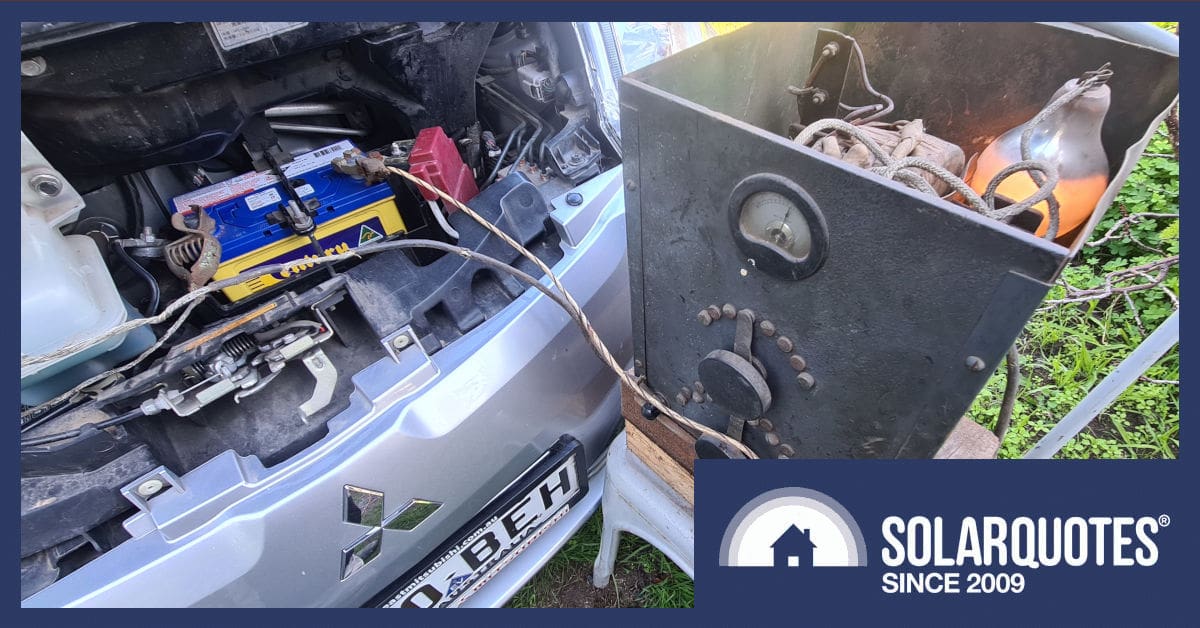
Some standards live forever. That’s a 100-year-old battery charger with a glowing valve rectifier maintaining an EV.
Running late on the morning school run? That’s when problems tend to hit. Even with two EVs and a PHEV in the driveway, I’ve learned flat 12v batteries are still a problem, and keeping a few tools handy can save the day. Let me show you why charging a flat 12v battery can be quicker than shifting the kids’ car seats into a new car.
EVs Aren’t Space Ships
Despite incredible software advances and missteps in minimalist touchscreens, EVs are built from legacy vehicle technology. The traction motor and main battery pack might be 400 or 800 volts, with bright orange cables, but the surrounding architecture is garden-variety car parts.
12 volts Is A Standard In Motoring.
Despite 100+ years, wheel diameters are still measured in inches, Schrader valves keep the air in your tyres, and lead terminal posts have been a standard size since batteries were installed in cars to start combustion engines.
From 1919, Ford’s Model T got “electric equipment,” and through Volkswagen’s Beetle and the first Holden, most cars had 6 volt systems.
However, for the last 50+ years, almost everything—cars, motorcycles, lawnmowers, tractors, and many trucks—have been 12 volt. And despite the decline of smoking, the cigarette lighter has become the standard plug for powering accessories in your vehicle.
As an auto electrician, I find it laughable that cigarette lighters are limited to 150 watts at best. Yet, there are all manner of inverters, EV chargers & fridges plugged into the most dodgy socket invented. Depending on your car, these accessories can easily run the 12v battery flat.1
Without 12 volts You’ve Got Nothing
When you “turn the key” on your EV, the lights on the dash, the contactors that connect the traction battery, and the computers running the whole show rely on a 12-volt battery. Once the car is running, the 12-volt battery is charged from the main traction battery using an onboard charger. It’s not unlike the alternator, which is driven by a fan belt on the front of your combustion engine.
However, an EV is just like a conventional car. If the 12-volt battery is flat, you can’t start any of the systems, no matter how much energy is stored in the main traction battery.
Symptoms Can Be Cryptic
After sitting for a fortnight, my iMiev has been known to run the 12-volt battery down. The interior light develops a soft golden glow, but the dash still lights up when you turn the key.
For the observant, there aren’t as many clicks and whirrs as the vehicle starts, but the “fuel gauge” displays charge in the traction battery as usual. The key difference is that then it falls to zero and counts up2 slowly to indicate something is wrong with the 12-volt system. They could make it so simple with a dedicated warning light.
MacGyvering Things Is Possible
A portable car jumpstarter pack would be an easy solution, but I don’t own one. Instead, I stripped the ends of some scrap solar cable, jammed them into an 18-volt cordless drill battery, and connected it to the 12-volt battery under the bonnet. Paralleling these two incompatible batteries was a perfectly dodgy experiment.
To prevent damage to the car’s electronics, I relied on the flat car battery, pulling the small tool battery down to 12ish volts while simultaneously using the available energy to boot up the car system and engage the onboard 12-volt charger. I don’t suggest you try this at home, but it did work.

Perhaps MacGyver needs to update to an EV?
PHEV Has More Words But Less Information
My latest conundrum was pressing the start button and finding the usual clicks and whirrs replaced by beeps and flashing warning messages. “EV SYSTEM SERVICE REQUIRED” was the main one, along with the dreaded car picture dissected by an exclamation mark! It was a nice morning to walk to school anyway.
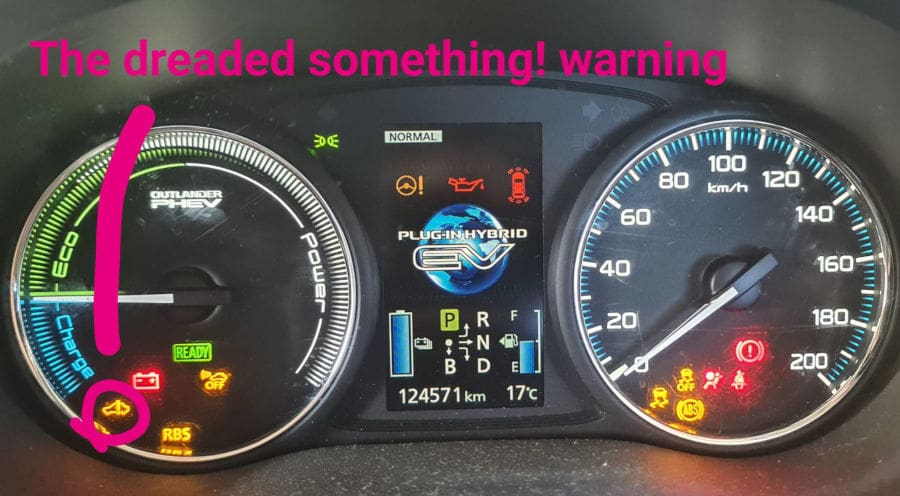
Error messages are displayed where it says “plug-in hybrid” but there’s no mention of the 12v battery being flat
When diagnosing it, I first noticed that the vacuum pump was noisy and rough, because without enough voltage it ran slow.
Cars normally use engine manifold vacuum to reduce pedal effort on the footbrake but EVs have none of that. Some EVs use an electric brake booster, many just adapt legacy car systems by using a vacuum pump.
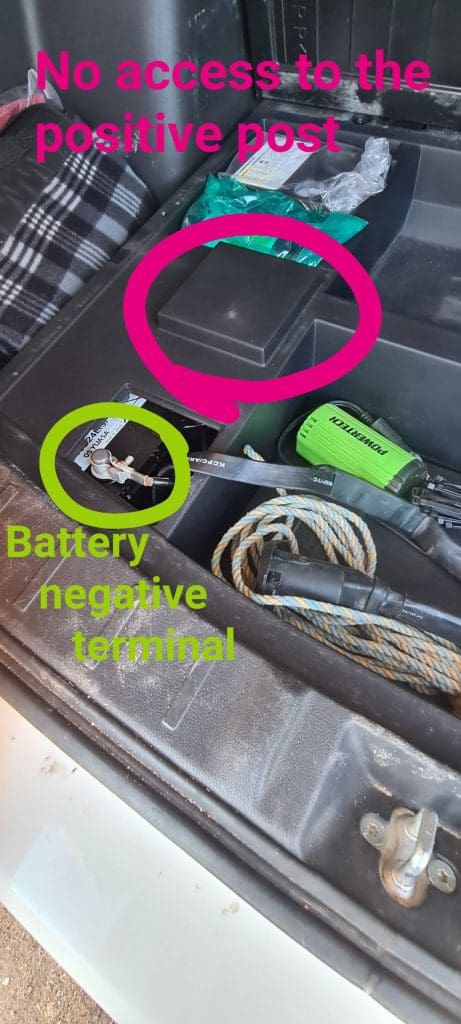
Design failure. The battery negative is available to disconnect, but access to the positive requires removing the whole boot floor with a screwdriver.
My multimeter showed the car battery was down to 9 volts, so I connected my old charger to give it a tickle. A few hours later, all was good with the world, but I was curious to find the root cause of the problem. Maybe it’s just that the factory-fitted 12 volt lead-acid battery in the boot is 10 years old now.
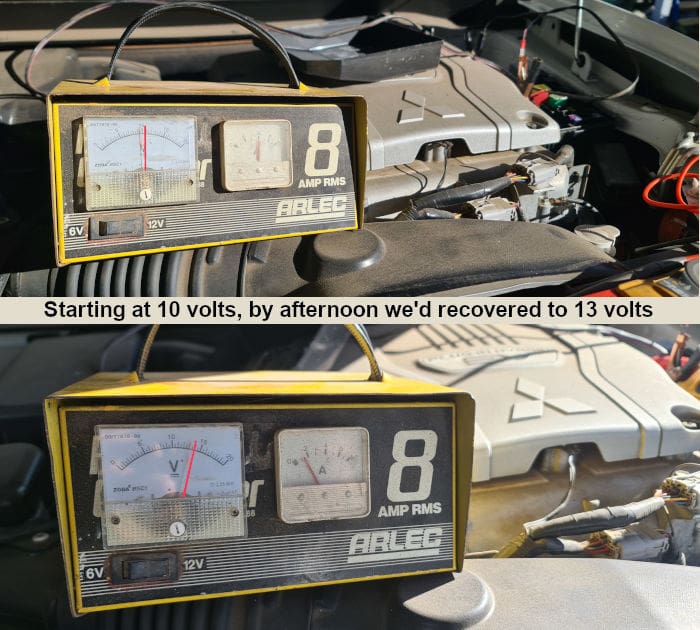
I installed a volt meter in this old charger. As the state of charge improves, voltage climbs and current (amps) decreases.
Yes, You Can Jump Start With An EV
While I always urge some caution and remind people that it’s not a sin to consult the instruction manual, there’s a standard procedure for charging any 12 volt car system, be it EV or ICE.
Click on this FAQ for a full rundown on how to safely jumpstart your car.
TL;DR Safety Messages
- DO NOT TRY TO CRANK AN ICE ENGINE USING JUMPER LEADS FROM AN EV DONOR CAR.
- DO NOT DISCONNECT JUMPER CABLES WITH EITHER CAR TURNED ON
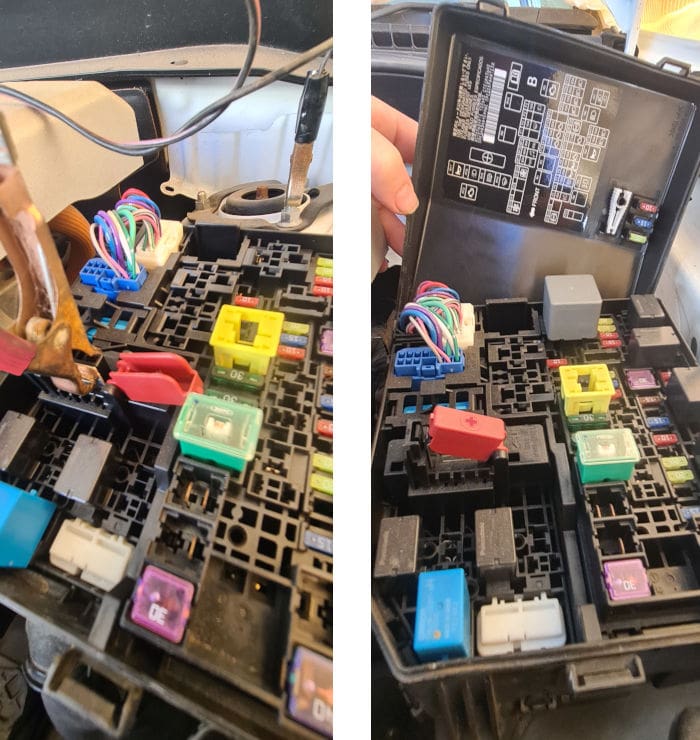
Under the bonnet of this car, there’s a fuse box. Remove the lid, flip open the red cover marked (+) and connect your charger leads
Modern Cars Are Very Reliable
You may never need a spare tyre, jack, or jumper leads, but these things aren’t completely redundant yet. Before scrapping Dad’s battery charger, it’s worthwhile leafing through your car manual. Some basic tools could prove a lot cheaper and faster than calling a tow truck because you forgot to unplug the car fridge.

 RSS - Posts
RSS - Posts



Yep, the Jumpstart is the Go. Once powered up, the 12v will charge off the traction battery.
On the Kona, there is a setting to automatically charge the 12v battery if it gets low (charging when the green LED lights on the grill.)
My 12v battery on the Kona has been marked for change by Hyundai service for well over 18 months. They test it with a Load tester! (Why?)
btw, with your Imiev, make sure the undertray is there. Easy to break, but the AC pump gets wet if it is missing. Ours now has an Aluminium undertray, new DIY lid on the AC pump electronics, with a surfboard valve in the new lid (The valve allows moisture to escape) No problems for 4+ years now.
regards, Doug
Our MG4’s 12V auxiliary battery is charged while ever the car’s drive battery is itself is being charged, and it is also charged while driving.
I have the car’s info systems integrated with Home Assistant and monitor the auxiliary battery voltage, even set an alert should it drop below a voltage threshold. The car will also automatically provide a top up charge from the drive battery if so required.
48V is the new standard. Of course the headlights in some modern cars are almost double that. Higher volts, less Amps for the same power, and given we are seeing electric fans, water pumps and even supercharging it makes the engine bay a lot simpler and somewhat safer without those belts.
I wish you were correct Wally. The only current production vehicle with a 48V low voltage system is the Cybertruck (A US only vehicle). I believe some other automakers are interested because they can use less copper, but it’s doubtful they’ll move any time soon.
Apparently my Mad Musk Tesla will tell me when it needs a new 12 volt battery. I listen to it for everything else, so I guess I’ll just wait until I’m told.
Yep, as does my 2014 BMW i3 which has had its first replaced already
What a crazy world. There we have a perfectly good modern lithium battery, strong enough to move a car around for hundreds of km and yet we need a 12V (lead acid) battery. Why don’t they simply use a DC-DC voltage converter that provides the 12 Volts from the big battery? It’s not like we need to crank over an ICE, so surely this should be a big deal.
They do use a DC-DC converter – that’s how the 12V battery get’s charged. But the DC-DC converter is limited in capacity. For example it can’t drive the power steering pump on it’s own – it needs supplemental power from the 12V system. And there will be various circumstances where the limit of the DC-DC converter is reached – eg when your windscreen wipers, air con and demister are running at the same time. The 12V battery acts like ballast for the DC-DC converter during high amps on the 12V system. To build a DC-DC converter with enough power to run a modern 12V car system would be too heavy too expensive. Soon I think modern car systems will move to 48V on the low voltage side but there are a millions of components manufactured that will have to change.
Of course you are right, they obviously already must have a DC-DC converter in electric vehicles. But if it’s true what you are saying and the converter isn’t strong enough to run these accessories at the same time, what difference does it make if you are driving or not. The 12V battery would go flat in no time regardless, as the converter could not keep up.
However, my actual point is, even if a small 12V battery is required to act as a buffer, as you are saying, or for whatever reason, why don’t they at least keep this battery charged with the DC-DC converter, so you don’t have to worry about it running flat as Anthony describes in his article?
You would think they could use a Supercap…
The reason the 12v battery is there is because regulations require it (or so I was told…). Mind you, the 12v batteries are not that reliable anyway.
👍 Supercapacitors would be the way to go, in any type of car I suppose. Although the old car batteries, lasting only a few years, is big business ☹️… but that’s an entirely new topic.
I believe it’s a safety issue, the high voltage traction is not connected u less / until the computer tells the 12 volt control system it’s checked and it’s OK to close the ‘contactor’ switch on the battery.
There’s always one big switch and one big fuse between the High Voltage battery and the rest of the car.car.
Safety sounds plausible, however you would think a little trickle charger in the mA range, bypassing the whole setup, shouldn’t be a problem when it comes to safety. Just enough to keep our 12V side in a ready state. I and if it is galvanically separated, the car wouldn’t even “know” it’s there.
Hi Meini
Regulated output maintenance chargers are common on classic collector cars that are seldom used, marques like Porsche supply them with new cars and I know there are EV owners who do exactly the same.
Yes Anthony, something like this is what I am referring to, however instead of getting its power from mains, it would be connected to the main traction battery and be a permanent fixture. It would have to work with 400V DC or so instead of 230V AC, but otherwise it would do basically the same thing.
(Sorry, there was no reply button on your post, so I started at the top level again)
Hi Meini,
Yeah nah, running a 12v charger full time is going to run the traction battery flat. Some vehicle do a scheduled top up I think, Others charge the 12v when the traction pack is being charged. Otherwise the 12v gets charged when driving.
Maintenance needs to be a small solar panel or mains supply.
Teslas seem to be the only make now with a 12V LiFP battery after Peter May from Top Gear could not even open his Tesla and told the web about it. Just getting at the battery to change it was also a major drama.
With standard lead acid batteries only lasting three years in the worst case, soon every major brand will have a 12V LiFP battery for “starting”.
A major drama – it’s a couple of clips on the cover? I’ve seen ICE cars with harder to get to batteries. Typical Top Gear BS.
It is a much more expensive battery but it is also a much more reliable battery that should be good for 15 years plus.
There’s no manual hood release on a Model S.
I think you have to disassemble part of the front bumper to get to a charging post that’ll power the hood release.
On some cars (not sure if Tesla is one) you can just plug a trickle charger or solar panel into the lighter plug. Assuming you can get in.
In a pinch you could break a side window, as Elon has demonstrated.
Thank you for the tips. I still have a portable jump-start kit from pre-EV days – it also has USB outlets for emergency charging of phones etc.
Can I suggest that Solarquotes starts using the term Fossil Fuel Vehicle (FFV) instead of ICE (or “combustion engine”). Hydrogen-fuelled vehicle are a subset of ICE and they should not be tarred with the same brush!
My Leaf’s 12V battery went flat enough to allow the car to start, but not enough to make the brakes work.
Quite scary when I started to reverse out of our drive (steep down hill) and realised there was nothing to stop me.
Very cautiously drove back in, looked up why and put the car charger on.
All ok ever since.
I like the term ICE: you have to be on drugs to drive one! (TIC).
I think Hydrogen is a myth anyway: Why carry fuel around that leaks from its containers when we have perfectly good electrons that flow down wires?
I think Ammonia is a better option, but we will need to design systems to efficiently use it. NH3 is more energy dense anyway. Anyway, we could call Hydrogen powered ICE: ´HICE´, that would differentiate it.
btw, I am not saying that H2 is useless: Just do not transport it in ICE powered trucks! H2 is useful to power backup power systems, where it is generated & stored locally, & turned back into water locally too. (I wonder if Electrolysis could efficiently work on polluted water? The output from the H2 use would be pure water.)
It’s worth nothing that EV manufacturers are increasingly switching their low voltage power systems over from lead acid batteries to LFP battery packs with integrated battery management systems.
You’d still have the same problems with being unable to turn the car on if you do somehow manage to run the low voltage battery flat, but an LFP battery will last a lot longer than a typical lead acid battery and it’s also far less likely to suddenly die on you like a lead acid battery can.
It’s often more difficult to flatten the battery in these more modern low voltage power systems too. For example the LFP battery in my BYD Seal will recharge itself from the main battery whenever it needs to, even if the car is “off” at the time.
Sounds reassuring Anthony. Thanks for the info. A friend of mine bought one of the first BYD Atto and he told me that he has trouble with his lead acid battery. I thought he was joking … glad that’s fixed. 🙂